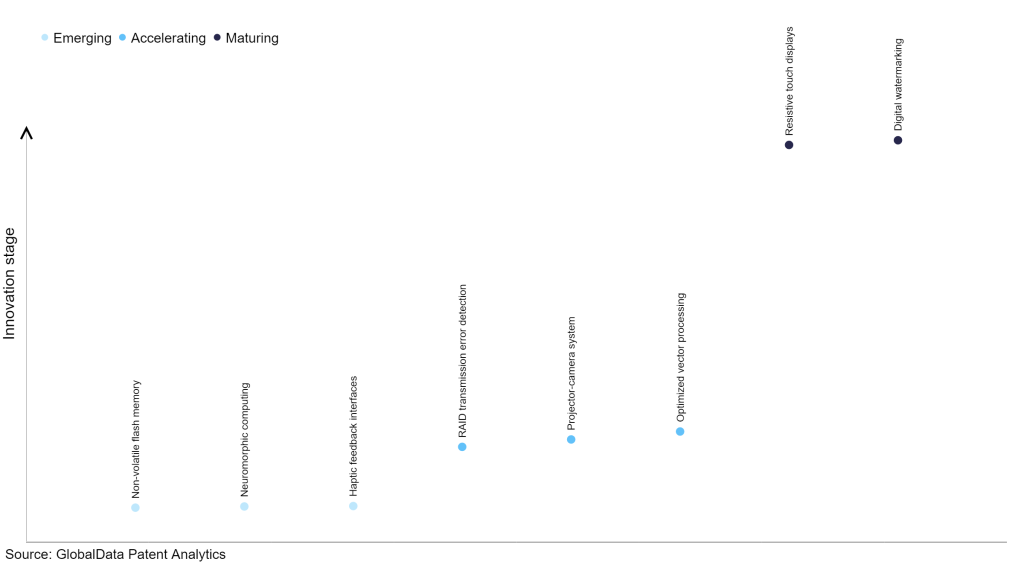The technology industry continues to be a hotbed of patent innovation. Activity is driven by the increasing demand for scalable and cost-effective computing solutions, the need for processing massive amounts of data, and the rise of data-intensive applications, and growing importance of technologies such as cloud-based grid computing, virtualization, workload management and distributed file systems, and high-speed networking. In the last three years alone, there have been over 1.5 million patents filed and granted in the technology industry, according to GlobalData’s report on Innovation in technology: grid computing. Buy the report here.

Access deeper industry intelligence
Experience unmatched clarity with a single platform that combines unique data, AI, and human expertise.
However, not all innovations are equal and nor do they follow a constant upward trend. Instead, their evolution takes the form of an S-shaped curve that reflects their typical lifecycle from early emergence to accelerating adoption, before finally stabilizing and reaching maturity.
Identifying where a particular innovation is on this journey, especially those that are in the emerging and accelerating stages, is essential for understanding their current level of adoption and the likely future trajectory and impact they will have.
185+ innovations will shape the technology industry
According to GlobalData’s Technology Foresights, which plots the S-curve for the technology industry using innovation intensity models built on over 1.6 million patents, there are 185+ innovation areas that will shape the future of the industry.
Within the emerging innovation stage, non-volatile flash memory, neuromorphic computing, and haptic feedback interfaces are disruptive technologies that are in the early stages of application and should be tracked closely. RAID transmission error detection, projector-camera system, and optimized vector processing are some of the accelerating innovation areas, where adoption has been steadily increasing. Among maturing innovation areas are resistive touch displays and digital watermarking, which are now well established in the industry.
Innovation S-curve for the technology industry

Grid computing is a key innovation area in technology
Grid computing refers to the utilization of distributed resources to address extensive computational challenges, without altering its meaning. It entails a network of interconnected computers or nodes that collaborate in resource and workload sharing. Grid computing proves valuable in tackling intricate problems demanding substantial processing power beyond the capacity of a single computer.
GlobalData’s analysis also uncovers the companies at the forefront of each innovation area and assesses the potential reach and impact of their patenting activity across different applications and geographies. According to GlobalData, there are 1045+ companies, spanning technology vendors, established technology companies, and up-and-coming start-ups engaged in the development and application of grid computing.
Key players in grid computing – a disruptive innovation in the technology industry
‘Application diversity’ measures the number of applications identified for each patent. It broadly splits companies into either ‘niche’ or ‘diversified’ innovators.
‘Geographic reach’ refers to the number of countries each patent is registered in. It reflects the breadth of geographic application intended, ranging from ‘global’ to ‘local’.
International Business Machines (IBM) is the leading patent filer in grid computing. The company’s patents are aimed at systems and methods for generating synthetic data. The system includes a data generator that generates synthetic data based on a training dataset, which may include real-world data or synthetic data.
The data generator may use artificial intelligence to generate the synthetic data, which can be used to train machine learning models, test software, and perform other tasks. The system may also include a data repository that stores the synthetic data. The data repository may be accessible to users who need to use the synthetic data. The users may include machine learning engineers, software developers, and other data scientists.
Other prominent patent filers in the space include Microsoft and Intel.
By geographic reach, Equinix leads the pack, followed by Snowflake and Intel. In terms of application diversity, Intel holds the top position, followed by International Business Machines (IBM) and Microsoft.
Cloud innovation in grid computing has revolutionized the way large-scale computational tasks are executed. By leveraging the power of cloud computing resources, grid computing can efficiently handle complex and resource-intensive computations across distributed networks. Major technologies involved in cloud-based grid computing include virtualization, workload management systems, distributed file systems, and high-speed networking.
These technologies enable organizations to leverage the flexibility, scalability, and cost-efficiency of the cloud to execute large-scale computations, accelerate research and development, and achieve faster time-to-insights, thus driving the growth of the grid computing market.
To further understand the key themes and technologies disrupting the technology industry, access GlobalData’s latest thematic research report on Technology.
Data Insights
From

The gold standard of business intelligence.
Blending expert knowledge with cutting-edge technology, GlobalData’s unrivalled proprietary data will enable you to decode what’s happening in your market. You can make better informed decisions and gain a future-proof advantage over your competitors.







